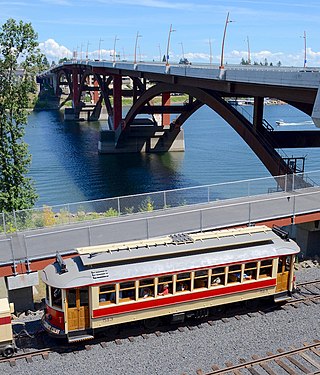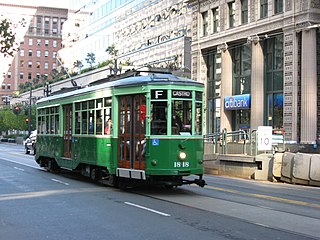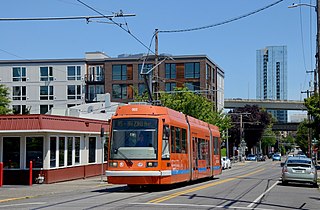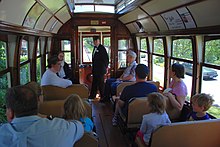
Issaquah is a city in King County, Washington, United States. The population was 40,051 at the 2020 census. Located in a valley and bisected by Interstate 90, the city is bordered by the Sammamish Plateau to the north and the "Issaquah Alps" to the south. It is home to the headquarters of the multinational retail company Costco. Issaquah is included in the Seattle metropolitan area.

A heritage railway or heritage railroad is a railway operated as living history to re-create or preserve railway scenes of the past. Heritage railways are often old railway lines preserved in a state depicting a period in the history of rail transport.

The Willamette Shore Trolley is a heritage railroad or heritage streetcar that operates along the west bank of the Willamette River between Portland and Lake Oswego in the U.S. state of Oregon. The right-of-way is owned by a group of local-area governments who purchased it in 1988 in order to preserve it for potential future rail transit. Streetcar excursion service began operating on a trial basis in 1987, lasting about three months, and regular operation on a long-term basis began in 1990. The Oregon Electric Railway Historical Society has been the line's operator since 1995.

A Birney or Birney Safety Car is a type of streetcar that was manufactured in the United States in the 1910s and 1920s. The design was small and light and was intended to be an economical means of providing frequent service at a lower infrastructure and labor cost than conventional streetcars. Production of Birney cars lasted from 1915 until 1930, and more than 6,000 of the original, single-truck version were built. Several different manufacturers built Birney cars. The design was "the first mass-produced standard streetcar " in North America.

The F Market & Wharves line is one of several light rail lines in San Francisco, California. Unlike most other lines in the system, the F line runs as a heritage streetcar service, almost exclusively using historic equipment both from San Francisco's retired fleet as well as from cities around the world. While the F line is operated by the San Francisco Municipal Railway (Muni), its operation is supported by Market Street Railway, a nonprofit organization of streetcar enthusiasts which raises funds and helps to restore vintage streetcars.

The San Diego Electric Railway (SDERy) was a mass transit system in Southern California, United States, using 600 volt DC streetcars and buses.

The Peter Witt streetcar was introduced by Cleveland Railway commissioner Peter Witt (1869–1948) who led the transit agency from 1911–1915 and designed a model of streetcar known by his name that was used in many North American cities, most notably in Toronto and Cleveland.

Old Pueblo Trolley is a non-profit, educational corporation based in Tucson, in the U.S. state of Arizona, that is dedicated to the preservation of Arizona's mass transit history. The name also commonly refers to the heritage streetcar line which OPT began operating in 1993, on which service is currently indefinitely suspended. OPT consists of three divisions that each fill a specific role in preserving the state's mass transit history. The divisions are the Street Railway Division, Motor Bus Division and the Museum Division.

The Charlotte Trolley was a heritage streetcar that operated in Charlotte in the U.S. state of North Carolina. The line ran along the former Norfolk Southern right of way between Tremont Avenue in the Historic South End in a northerly direction to its terminus at 9th Street Uptown. It ran on tracks mostly shared with the LYNX Blue Line.

The Fort Smith Trolley Museum is a streetcar and railroad museum in Fort Smith, in the U.S. state of Arkansas, which includes an operating heritage streetcar line. The museum opened in 1985, and operation of its streetcar line began in 1991. Four vehicles in its collection, a streetcar and three steam locomotives, are listed on the National Register of Historic Places (NRHP). The now approximately three-quarters-mile-long (1.2 km) streetcar line also passes four NRHP-listed sites, including the Fort Smith National Historic Site, the Fort Smith National Cemetery, the West Garrison Avenue Historic District and the 1907 Atkinson-Williams Warehouse Building, which now houses the Fort Smith Museum of History.

Streetcars or trolley(car)s were once the chief mode of public transit in hundreds of North American cities and towns. Most of the original urban streetcar systems were either dismantled in the mid-20th century or converted to other modes of operation, such as light rail. Today, only Toronto still operates a streetcar network essentially unchanged in layout and mode of operation.

The MATA Trolley is a heritage streetcar transit system operating in Memphis, Tennessee. It began operating on April 29, 1993. Service was suspended in June 2014, following fires on two cars. After nearly four years and repeated postponements, the reopening of the Main Street Line took place on April 30, 2018. The system's two other lines remained suspended as of December 2022, but with reopening of both planned. In 2021, the system had a ridership of 237,900.

The New York Museum of Transportation (NYMT), founded in 1975, is a non-profit organization located at 6393 East River Road, in the Rochester suburb of Rush. A private rail line built by volunteers connects NYMT with the Rochester & Genesee Valley Railroad Museum, over a distance of two miles. This demonstration railway allows both museums to offer train rides with their collections of vintage railroad equipment. NYMT operates the only electric trolley ride in New York State, not to be confused with the similarly named Trolley Museum of New York located in Kingston, New York.
The Gomaco Trolley Company is a manufacturer of vintage-style streetcars, located in Ida Grove, Iowa, United States. The company has supplied replica-vintage streetcars to several transit systems in the US, and has also restored and rebuilt authentic vintage streetcars for some systems.

The Whitehorse Waterfront Trolley was a heritage streetcar service in Whitehorse, Yukon, Canada.

The Loop Trolley is a 2.2-mile (3.5 km), 10-station heritage streetcar line in and near the Delmar Loop area of greater St. Louis, Missouri. It opened for service in 2018, then shut down in 2019 after revenue fell far short of projections. Service resumed in 2022 under the Metro Transit division of the Bi-State Development agency.

The Astoria Riverfront Trolley is a 3-mile (4.8 km) heritage streetcar line that operates in Astoria, Oregon, United States, using former freight railroad tracks along or near the south bank of the Columbia River, with no overhead line. The service began operating in 1999, using a 1913-built streetcar from San Antonio, Texas. As of 2012, the service was reported as carrying 35,000 to 40,000 passengers per year and has been called a "symbol" and "icon" of Astoria. The line's operation is seasonal, normally during spring break and from May through September.

The North South Line is a streetcar service of the Portland Streetcar system in Portland, Oregon, United States. Operated by Portland Streetcar, Inc. and TriMet, it travels approximately 4.1 miles (6.6 km) per direction from Northwest 23rd & Marshall to Southwest Lowell & Bond and serves 39 stations. The line connects Portland's Northwest District, Pearl District, downtown, Portland State University (PSU), and South Waterfront. It runs every day of the week between 15 and 18 hours per day and operates on headways of 15 to 20 minutes.

The Oranjestad Streetcar is a single-track tram line in Oranjestad, the capital city of Aruba. It is owned and operated by Arubus, the national public transportation company. It was built as a key component of a larger project to upgrade the main retail areas of the town, other aspects of which included pedestrianization of streets, planting of trees, installation of ornamental street lighting and resurfacing of streets and sidewalks.






















